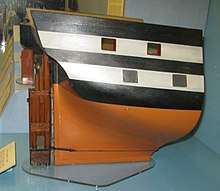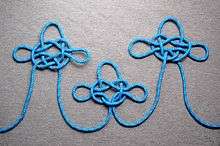Jury rigging
Jury rigging (also called "jerry rigging") is both a noun and a verb describing makeshift repairs made with only the tools and materials at hand. Its origin lies in such efforts done on boats and ships, characteristically sail powered to begin with. After a dismasting, a replacement mast and if necessary yard would be fashioned and stayed to allow a craft to resume making way.
| Look up jury-rig in Wiktionary, the free dictionary. |
Etymology
The adjectival use of "jury", in the sense of makeshift or temporary, has been said to date from at least 1616 when according to the 1933 edition of the Oxford Dictionary of the English Language it appeared in John Smith's A Description of New England.[1] It appeared in Smith's more extensive The General History of Virginia, New-England, and the Summer Isles published in 1624.[2] The phrase "jury rigged" has been in use since at least 1788.[1]
Two theories about the origin of this usage of "jury rig" are:
- A corruption of jury mast—i.e. a mast for the day, a temporary mast, being a spare used when the mast has been carried away. (From French jour, "a day".[3])
- From the Latin adjutare ("to aid") via Old French ajurie ("help or relief").[4]
Rigging


Depending on its size and purpose a sail-powered boat may carry a limited amount of repair materials, from which some form of jury rig can be fashioned. Additionally, anything salvageable, such as a spar or spinnaker pole, could be adapted to carrying a form of sail.
Ships typically carried a selection of spare parts (e.g., items such as topmasts), but at up to 1 meter (3 ft 3 in) in diameter the lower masts were too large to freight spares. Example jury-rig configurations include:
- A spare topmast
- The main boom of a brig
- Replacing the foremast with the mizzenmast (mentioned in W. Brady's The Kedge Anchor (1852))
- The bowsprit set upright and tied to the stump of the original mast.
The jury mast knot provides anchor points for securing makeshift stays and shrouds to support a jury mast, in spite of a body of evidence of the knot's actual historical use.[5]
Jury rigs are not limited to boats designed for sail propulsion. Any form of craft found without power can be adapted to carry jury sail as necessary. In addition, other essential components of a boat or ship, such as a rudder or tiller, can be said to be "jury rigged" when a repair is improvised out of materials at hand.
Similar phrases
- The compound word "jerry-built", a similar but distinct term referring to things "built unsubstantially of bad materials", has a separate origin from "jury-rigged". The exact etymology is unknown, but it is probably linked to earlier pejorative uses of the word "jerry", attested as early as 1721, and may have been influenced by "jury-rigged".[lower-roman 1][lower-roman 2][lower-roman 3]
- Afro engineering (short for African engineering)[lower-roman 4] or "nigger rigging"[lower-roman 5] describes a fix that is temporary, done quickly, technically improperly, or without attention to or care for detail. It can also describe shoddy, second-rate workmanship with whatever materials happen to be available.[lower-roman 6] "Nigger-rigging" originated in the 1950s;[lower-roman 4] the term was euphemized as "afro engineering" in the 1970s.[lower-roman 5][lower-roman 7] The terms have been used in the auto mechanic industry to describe quick makeshift repairs.[lower-roman 8] These phrases have largely fallen out of common usage due to racist, pejorative connotations.[lower-roman 9][lower-roman 10][lower-roman 11][lower-roman 12]
- To "MacGyver" something is to rig up something in a hurry using materials at hand, from the title character of the American television show of the same name, who specialised in such improvisation stunts.[lower-roman 13]
- In New Zealand, having a "Number 8 wire" mentality means to have the ability to make or repair something using any materials at hand (such as standard farm fencing wire).[lower-roman 14]
See also
- Bricolage – creations from whatever happens to be available
- Rube Goldberg - an American cartoonist known for drawing complicated machines used for simple purposes
- Jugaad – innovative or simple fixes that may bend certain rules
- Kludge – inelegant solutions that are difficult to maintain
- Repurposing
- Upcycling – the transformation of waste into something usable for environmental preservation
- W. Heath Robinson – a British artist known for drawing complicated machines used for simple purposes
- Exaptation – a shift in the function of a trait during evolution
- Robinsonade – a literary genre named after the novel Robinson Crusoe
- Sailing ship accidents
References
- The Oxford English Dictionary, Volume V, H-K (Oxford: Clarendon Press, 1933; corrected reprinting 1966), 637.
- Captaine Iohn Smith, The Generall Historie of Virginia, New-England, and the Summer Isles (London: Michael Sparkes, 1624; 2006 UNC digital republication), 223. (Online edition.) Note that in the orthography of Early Modern English 'J' was often written as 'I', thus the actual quote from Smith(1624) reads, "...we had re-accommodated a Iury-mast to returne for Plimoth..."
- E. Cobham Brewer 1810–1897. Dictionary of Phrase and Fable. 1898.
- Robert K. Barnhart, ed., Barnhart dictionary of etymology, (New York: H. W. Wilson Company, 1988), 560.
- Charles Hamel, "Investigations on the Jury Mast Knot" Accessed 2007-02-22.
References for similar phrases
- Israel, Mark (29 September 1997). "jerry-built"/"jury-rigged". alt.usage.english Word Origins FAQ. Archived from the original on September 27, 2013. Retrieved 28 February 2013.
- William and Mary Morris, Morris Dictionary of Words and Phrase Origins, 2nd Edition (New York: HarperCollins, 1988), 321–322.
- Wilton, Dave. "jerry-built / jury rig". wordorigins.org. wordorigins.org. Retrieved 28 February 2013.
- Green, Jonathan (2005). Cassell's Dictionary of Slang (2 ed.). London: Weidenfeld & Nicolson. p. 10, African engineering. ISBN 978-0-304-36636-1.
- Green, Jonathan (2005). Cassell's Dictionary of Slang (2 ed.). London: Weidenfeld & Nicolson. p. 1003, nigger rig n.; nigger rig v.; nigger rigged. ISBN 978-0-304-36636-1.
- Partridge, Eric (2006). The New Partridge Dictionary of Slang and Unconventional English: J-Z. Taylor & Francis Group. p. 1370, nigger-rig. ISBN 978-0-415-25938-5.
- Jackson, Shirley A. (2015). Routledge International Handbook of Race, Class, and Gender. Routledge. Intersections of discourse: Racetalk and class talk. ISBN 978-0-415-63271-3.
'I can't even nigger-rig it.' ... 'The proper terminology is Afro-engineering.' Here, blackness is demarcated in a classed way. 'Nigger-rigging' is a quick, temporary fix to a problem, but it is a solution that is second rate to the 'right' way. ... declares that this type of knowledge is racialized and classed in a way that deems it inherently inferior. ... remarks remain unchallenged. Quite the opposite. ... implies that black ingenuity and innovation as subpar and second rate to white ingenuity and innovation. ... affirms this with his response. By responding indirectly ... consents to this classed usage of the word nigger. Not only does this trivialize whether the slur's usage is inappropriate in the first place, but it equates 'nigger-rigging' with 'Afro-engineering'. ... denotes these terms as synonymous, thus imposing an even more classed meaning to this racial slur.
- Poteet, Jim; Poteet, Lewis (1992). Car & Motorcycle Slang. toExcel an imprint of iUniverse.com Inc. p. 14, Afro engineering. ISBN 978-0-595-01080-6.
- Eisiminger, Sterling K. (1991). The Consequence of Error and Other Language Essays. P. Lang. p. 327. ISBN 978-0-82041-472-0.
- Aman, Reinhold (2005). Maledicta, Volume 3, Issue 2. Maledicta Press. Maledicta. p. 167, Afro engineering.
- Green, Jonathon (1996). Words Apart: The Language of Prejudice. Kyle Cathie. pp. 59. ISBN 978-1-85626-216-3.
- Droney, Damien. "Ironies of Laboratory Work during Ghana's Second Age of Optimism". Cultural Anthropology 29, no. 2 (2014): p. 363–384, Ironic Africa.
- Rich, John (2006). Warm Up the Snake: a Hollywood Memoir. Ann Arbor: University of Michigan Press. p. 167. ISBN 9780472115785. OCLC 67240539.
- "Time to 'break free' of No 8 wire mentality". Stuff.
Further reading
- John Harland, Seamanship in the Age of Sail (Naval Institute Press, 1984)